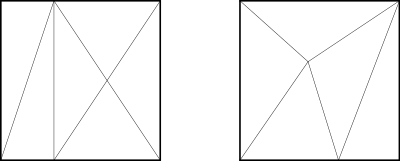Monsky's theorem
In geometry, Monsky's theorem states that it is not possible to dissect a square into an odd number of triangles of equal area.[1] In other words, a square does not have an odd equidissection.
The problem was posed by Fred Richman in the American Mathematical Monthly in 1965, and was proved by Paul Monsky in 1970.[2][3][4]
Proof
Monsky's proof combines combinatorial and algebraic techniques, and in outline is as follows:

- Take the square to be the unit square with vertices at (0,0), (0,1), (1,0) and (1,1). If there is a dissection into n triangles of equal area then the area of each triangle is 1/n.
- Colour each point in the square with one of three colours, depending on the 2-adic valuation of its coordinates.
- Show that a straight line can contain points of only two colours.
- Use Sperner's lemma to show that every triangulation of the square into triangles meeting edge-to-edge must contain at least one triangle whose vertices have three different colours.
- Conclude from the straight-line property that a tricolored triangle must also exist in every dissection of the square into triangles, not necessarily meeting edge-to-edge.
- Use Cartesian geometry to show that the 2-adic valuation of the area of a triangle whose vertices have three different colours is greater than 1. So every dissection of the square into triangles must contain at least one triangle whose area has a 2-adic valuation greater than 1.
- If n is odd then the 2-adic valuation of 1/n is 1, so it is impossible to dissect the square into triangles all of which have area 1/n.[5]
Optimal dissections
By Monsky's theorem it is necessary to have triangles with different areas to dissect a square into an odd number of triangles. Lower bounds for the area differences that must occur to dissect a square into an odd numbers of triangles and the optimal dissections have been studied.[6][7][8]
Generalizations
The theorem can be generalized to higher dimensions: an n-dimensional hypercube can only be divided into simplices of equal volume, if the number of simplices is a multiple of n!.[2]
References
- Aigner, Martin; Ziegler, Günter M. (2010). "One square and an odd number of triangles". Proofs from The Book (4th ed.). Berlin: Springer-Verlag. pp. 131–138. doi:10.1007/978-3-642-00856-6_20. ISBN 978-3-642-00855-9.
- Xu, Moor (April 4, 2012). Sperner's Lemma (PDF) (Technical report). University of California, Berkeley.
- Monsky, P. (1970). "On Dividing a Square into Triangles". The American Mathematical Monthly. 77 (2): 161–164. doi:10.2307/2317329. JSTOR 2317329. MR 0252233.
- Stein, S. (2004). Kleber, M.; Vakil, R. (eds.). "Cutting a Polygon into Triangles of Equal Areas". The Mathematical Intelligencer. 26: 17–21. doi:10.1007/BF02985395.
- Verrill, H. A. (September 8, 2004). "Dissecting a square into triangles" (PDF). Louisiana State University. Archived from the original (PDF) on August 18, 2010. Retrieved 2010-08-18.
- Mansow, K. (2003), Ungerade Triangulierungen eines Quadrats von kleiner Diskrepanz (en. Odd triangulations of a square of small discrepancy) (Diplomarbeit), Germany: TU Berlin
- Schulze, Bernd (1 July 2011). "On the area discrepancy of triangulations of squares and trapezoids". Electronic Journal of Combinatorics. 18 (1): #P137. Zbl 1222.52017.

- Labbé, Jean-Philippe; Rote, Günter; M. Ziegler, Günter (2018). "Area Difference Bounds for Dissections of a Square into an Odd Number of Triangles". Experimental Mathematics: 1–23. arXiv:1708.02891. doi:10.1080/10586458.2018.1459961.